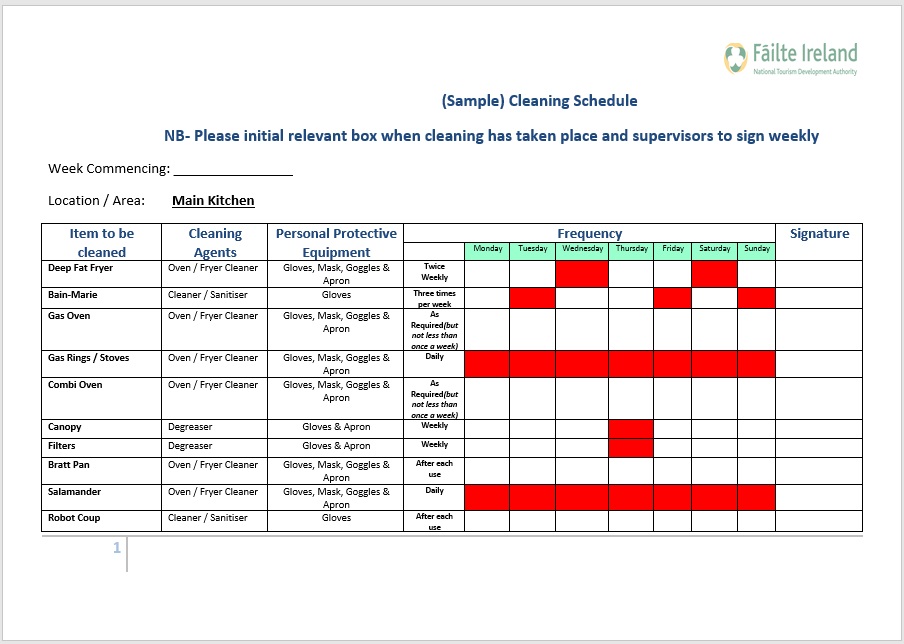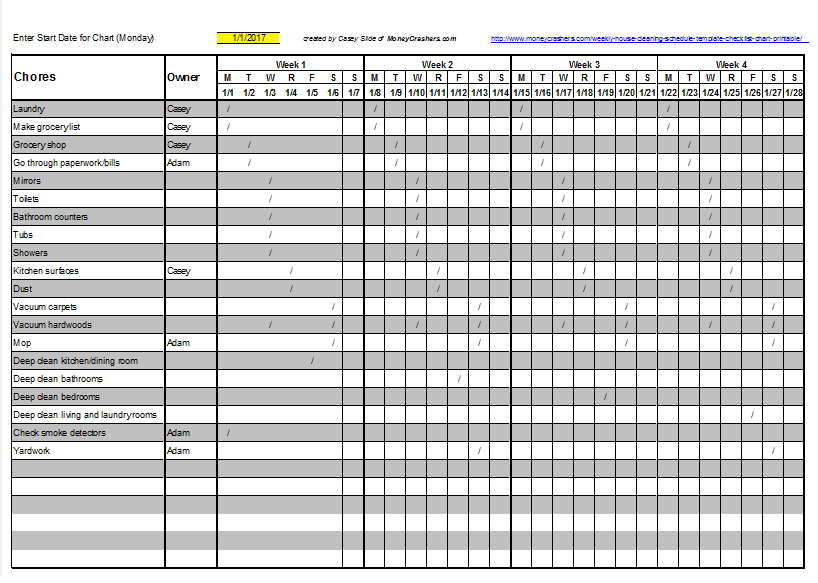Here is a collection of 9 Free Cleaning Schedule Templates created using MS Excel mostly. Cleaning is one of the many chores of household work and it is not easy because lots of activities are involved even in home cleaning. You can make cleaning of your office, home, or any other place easy by planning everything. A cleaning schedule will help you a lot to make things work properly and save you time in cleaning.
Your cleaning work can become easy through a well-organized cleaning system. It is really easy to design a cleaning schedule because you just have to assign different tasks on different days of the week and month according to their importance. You can design a schedule either for you only or for a group of people. You have to start your work by considering your cleaning requirements and major chores to distribute them equally according to time and requirements.
Key Components of an Effective Cleaning Schedule
A cleaning schedule is important to design in order to get a proper cleaning system and for your help, I am going to share some tips to design a perfect cleaning schedule:
To begin with, the cleaning schedule is an important template that outlays existing norms and requirements regarding the standards of cleanliness and hygiene to individuals and teams. It is more than a list of chores to do; it is at the same time a calendar and a self-control aid promoting the cleaning routine. A proper template facilitates coordination, reduces chances of missing out, and enhances discharge of cleaning responsibilities at homes, workplaces and institutions.
Essential Elements to Include
Necessary tasks are at the center of very cleaning schedule template. All cleaning tasks must have clear instructions about their performance including detailed description of their execution, so that it can be done without any variations. It is imperative that the tasks also have a frequency mentioned like if the task is to be performed daily, weekly, monthly or seasonally. This helps in considering how often to handle certain chores thereby ensuring all are handled without missing any out and helping to distribute priority accordingly past or not so urgent activities. Similarly, it is crucial to have a person or cleaning group regarded as responsible for paritcular tasks assigned. For each task, when well known who is going to perform the task, accountability and responsibility management becomes easier. A column or a space for denoting status of each task also comes in handy as it helps one quickly track activities which have been done, remaining and clears up any potential overlaps or omissions.
The Role of Customization
Every cleaning context has its own routine for how much and what needs to be cleaned. A house will include a variety of rooms – bedrooms, kitchens, bathrooms – whereas an office may contain common spaces that require more attention, restrooms, desks at workplaces, etc. Spick-and-span environments are more demanding, especially this applies to health care and educational facilities. The provision to create one’s own cleaning schedule unlike the cleaning schedule template already contains the format and fields required. additional time or supplies text area can be included in template if needed. Even images and colors may be used by some people in the templates. This flexibility means that the imagined template can be useful for lengthy processes which change over time in its service provision. When used as intended, an elaborate and personally modifiable template becomes an important aid to any health or cleaning system as it maintains order and omits decay.
Here is preview of a Weekly Cleaning Schedule Template prepared in MS Word to assist you.
Distribute Heavy Work Equally
Do not try to designate one day for all heavy work because it can exhaust you. It will be good to divide heavy chores into those days in which you have less work. In this way, you can save your time and health while doing major work.
Daily and Weekly Cleaning
It is necessary to make a separate list of regular cleaning tasks for your convenience. This list will contain those tasks that are necessary to perform every day such as dishwashing, sweeping, and other tidy works.
Some tasks are required to be done once a week including changing sheets, laundry, floor washing, bathroom, cleaning, furniture polishing, etc. You can divide these tasks in the different days of the week according to your convenience.
Rotation Cleaning
It will be good to assign a day for deep cleaning of rooms in your schedule on a rotating basis. It will help you to keep your work clean. You can do proper scrubbing on a regular basis or twice a week according to your availability.
Sample Weekly Schedule
You can easily design a weekly schedule after considering your cleaning requirements and for your help, the following is a sample weekly schedule:
- Monday: Dusting in all rooms.
- Tuesday: Vacuuming in the rooms on the main floor.
- Wednesday: Bathrooms and kitchen cleaning.
- Thursday: Dust and vacuum all rooms.
- Friday: Change bed sheets and laundry washing.
- Saturday: Mop floors or scrubbing.
- Sunday: free or assign something light to you.
I hope the above-given details are enough for your help in the designing of the cleaning schedule to get an organized cleaning system.
Here is another Sample Cleaning Schedule Template in MS Word Format.
Types of Cleaning Schedule
A cleaning schedule may have different formats which are suitable for each frequency, surroundings, or purposes. Knowing the different cleaning schedule templates helps people and organizations know which format to choose based on their cleaning priorities, work cycle, and size of operations. With the right template, the level of cleanliness can be significantly increased, and so can the uniformity of tasks as well as making the whole cleaning regime run along trouble-free and easy to monitor over the period.
Daily, Weekly, and Monthly Cleaning Schedules
The most popular types of templates are those that are based on frequency since these are the most applicable both at home and in workplaces. The cleaning schedule template template prepared for everyday use contemplates the execution of any simple everyday tasks, as such, cleaning a floor, taking out the garbage or sanitizing surfaces. The templates of this nature, are well arranged, with either a very detailed schedule of tasks or a simple list of tasks to make sure that every aspect in the cleaning schedule is covered. The weekly cleaning template, on the other hand, is suited for activities which should be done every few days but do not need to be carried out everyday. These activities can include cleaning carpets, washing floors or sanitizing areas which are not touched as often. Cleaning schedules for every month facilitate the advance or regular cleaning carried out every few months, which would include foods preparation and serving areas when applicable or the weekly or daily cleaning. Templates formulated along such lines cater for cleaning activities in a manner that allows for immediate and more proactive interventions to be applied when the situation at hand dictates so.
Industry-Specific Templates
Cleaning schedules vary depending on the type of business. Cleaning schedule templates for residential purposes encompass family housing or apartment buildings and normally consist of rooms or zones such as bedrooms, kitchens, bathrooms, or even storerooms. On the other hand, commercial templates are about what is done in an office, aborted, or hotel and require more emphasis on common areas, reception, and workstations. In healthcare institutions, there are templates for cleaning schedule and infection control with defined surfaces and equipment to be sanitized at specific times. Schools and any other institutions which deal with children such as daycare centers have templates which elaborate on how, when, and what surfaces in the classrooms, toilets, and other areas’ walls should be cleaned, and these surfaces are most of the time cleaned in accordance to health and safety regulations.
Best Practices for Implementing Cleaning Schedules
Creating a cleaning schedule template is more than just populating blocks on a chart; it incorporates planning, organization, and supervision for efficiency optimally. It does not matter if they are being implemented at home, at the workplace or at a service industry, the intention is to plan work as per the schedule so as to maintain hygiene, minimize spread of germs, and ensure activities are well managed within time lines. Best approaches on how practices are adopted usually turn a simple cleaning schedule to a potent action plan on how to keep a place tidy and in order.
Regularly Updating and Reviewing the Schedule to Accommodate Changes
An essential practice that is frequently overlooked is the adoption of a cleaning schedule and acceptance of its digital form. Management tasks and schedules vary over time due to many factors, some of which may include changes in staffing levels within the organization, the purchase of extra equipment, or reassessments caused by new climatic seasons. It is crucial to periodically evaluate the cleaning schedule of the different cleaning sections to keep the scheduling up to date. Inspections done weekly or monthly ensure that focus is placed on areas that might need cause attention or modification. When some activities are often not completed as planned, such a trend may mean that there is a need to readjust the available resources and time frames.
Ensuring Clear Communication and Accessibility of the Schedule to All Stakeholders
Additionally, facilitating proper planning for a successful clean-up exercise also involves ensuring that the cleaning schedule is effortless for all parties to access and comprehend. Maintaining easily readable cleaning schedules especially in public places or an online forum where all of them are provided helps everyone understand what is expected of him or her. There is less misunderstanding and there is more commitment among members when tasks are distributed explicitly in a cleaning schedule and their execution period is described. People also feel more in control of the situation and can express themselves freely if, for instance, they are uncomfortable with something.
Monitoring Compliance and Providing Feedback for Continuous Improvement
It is important to adhere to the cleaning schedule as this how most practices are brought into success. If such persons are physically located at the laundry area during the scheduled time, it is settled. On the contrary, improving the morale and addressing the effectiveness of the practices can be achieved by providing immediate feedback and accreditation for jobs well done. Equally so, the performance shortfalls in any differences can be counteracted by resentful comments. Over a period of time, the control over the supplanting, as well as complaints received, contributes to the improvement of the cleaning schedule and its adjustment according to the conditions existing in practice.
By applying these best practices, organizations and households alike can ensure that their cleaning schedules are practical, sustainable, and truly effective in maintaining a clean and healthy environment.









